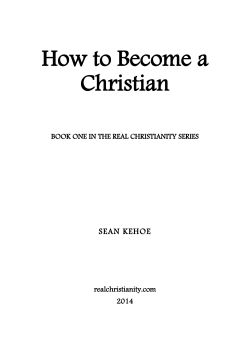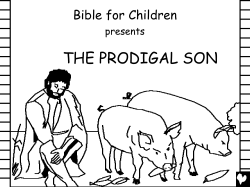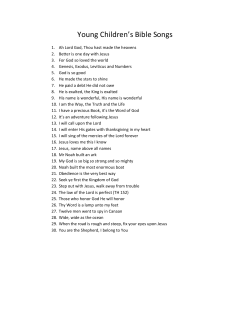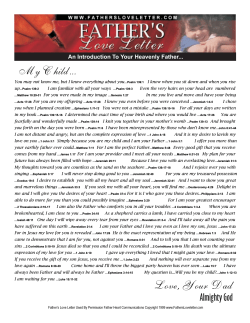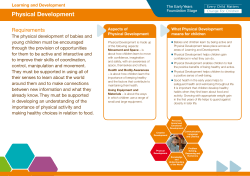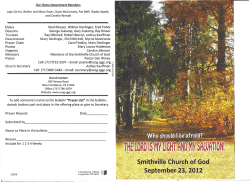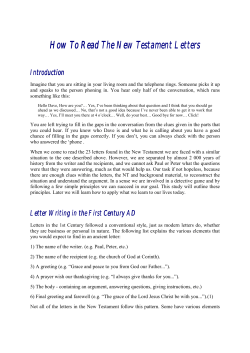
Document 66331
Year R Unit 6: OUR SPECIAL WORLD Week 1: What a lot of people! The areas of learning and development which will be primarily addressed through the units will be: Personal, Social and Emotional Development Understanding the World In addition, the following will be addressed in various ways: Communication and Language Literacy Expressive Arts and Design. Religious Education Learning Intentions: AT2: To begin to think about the world as a special place and to wonder about its size and variety. Resources: A Life Like Mine: How Children Live Around the World by Jemima Khan and UNICEF ISBN:0751339822 Children Just Like Me: A Unique Celebration of Children Around the World by Anabel Kindersley and UNICEF ISBN: 0751353272 Skin I'm In by Pat Thomas ISBN: 0764124595 All Kinds of People by Emma Damon ISBN: 1857070674 Whoever You Are by Mem Fox ISBN: 0152060308 Stories from Around the World by Heather Amery ISBN: 0746042078 Includes traditional stories from countries, including: New Zealand, India, Mexico, Germany www.earth.google.com facility provided by ‘Google’ (search engine) which enables user to view arial photographs of the most of the world! www.oxfam.org.uk/education/resources/mapping_our_world/ resources and information on OXFAM charity work. Suggested Planned/Teacher Directed Activity Look at a variety of atlases, globes and maps with the children. Help them begin to appreciate the size of their village/town/country/world! Look up the local area on the interactive White Board using ‘Google Earth’ which can be accessed at www.earth.google.com . Use the function to view familiar landmarks as photographs and zoom in and out to emphasize the size of the country/earth! Go to www.oxfam.org.uk/education/resources/mapping_our_world/ for some brilliant visual resources suitable for the interactive white board. Most of the material is aimed at older children, but the ‘spinning, tilting globe in ‘Lesson 1’ is a great way to share pictures of the world with your class! Talk about the animals and plants that call our world ‘home’. Take the children on a walk around the school grounds or the local area to look for ‘living things’ e.g. mini beasts, plants, birds and animals. Give the children clipboards and writing/colouring resources or digital cameras to record what they see. Ongoing activities/resources to take learning forward Talk about different towns, counties, countries that the children may have been to on their holidays or day trips. Talk about language/ landscape/weather etc How are the places similar/different to the town/village where the children live? Talk about transport and travel – use a globe/map to point out roads and seas/oceans. Identify continents or countries and talk about how people might get to these destinations from school e.g. across to France on a train, Ireland on a boat, Scotland in a car or America on a plane. Use modes of transport to highlight distance to the children (you couldn’t walk to India!) and the vastness of the world. Provide the children with several bags and suitcases and a collection of clothing and holiday objects - ask the children to pack the bags for specific destinations e.g. shorts, T-shirts, sunglasses, flip flops and sun cream for a holiday to Spain. Clothes and objects could be substituted for picture cards that could be hidden in the sand tray for the children to sort. Discuss with the children how different/similar climate/landscape is in other places and point destinations out on a globe or map. Make a ‘Travel Agents’ Shop’ in the role play area. Provide the children with brochures for a variety of different holiday destinations e.g. in the UK, abroad, hot countries, skiing/cold holidays. Encourage the children to design, draw and write about an imaginary holiday destination. Read and dramatize traditional stories from other countries. Make ‘people’ paper chains and decorate with different skin tones/traditional costumes – look at the different things that children wear in other countries. Events/outings or visits Invite parents into class to talk about trips and holidays that they have been on in different parts of the world. Share appropriate photographs, video footage, flags, books, dance, simple cultural traditions, foods etc. Invite a parent or member of staff or community into class who originates from or has lived in another country. Share experiences and ask visitor to teach the children some simple words and phrases from another country. Year R Unit 6: OUR SPECIAL WORLD Week 2: Creation Religious Education Learning Intentions: AT1: To begin to think about Christian beliefs on God’s role in creation AT2: To begin to reflect on the world as a special place. Resources: Dottie and Buzz DVD: Programme 2 ‘Creation’. Channel 4 Productions. Product code: 400868 The Story of the Creation by Jane Ray. ISBN: 1852132817 One World by Michael Foreman ISBN: 184270334X. A brother and sister who spend their day playing on the beach by a rock pool create their own tiny marine world in a bucket. The Lion First Bible by Pat Alexander. ISBN: 978-0745961033 Suggested Planned/Teacher Directed Activity Ask children to imagine the world with no water, sun, plants, creatures or people. What do the children think that the world would look like? Invite the children to think about the world that we know today. Do they think that it has always been as it is now? Share ideas on children’s views of creation! Explain that the word ‘creation’ is used to talk about something being made or coming alive. Remind the children of the ‘special’ Christian book, the Bible. Tell the children that you are going to read from the beginning of the Bible, from a book called Genesis. Read Genesis 1:1 – 2:3 to the class from a Children’s Bible. Discuss the verses and explain that some Christians believe that God created the world and that Genesis tells us the order in which God made the things on the earth. With the class sitting in a circle or in small groups, recreate the story of creation using a sand tray and a water container (for land and sea) twigs, plastic flowers and small world animals and people. Use pictures from the story to illustrate and prompt the children into retelling the story in their own words. Ongoing activities/resources to take learning forward Retell the story of creation through drama and dance or through sequencing pictures or painting a picture of what was created on one day or on every day according to the Bible. Investigate the children’s own theories about how the world might have been created. Invite the children to paint pictures to represent their ideas. Look at other faith creation stories such as: Hindu creation and reincarnation stories, the Muslim creation story found in the Qur'an etc. Learn and discuss hymns and songs about creation such as: ‘He’s got the whole world in his hands’, Set up a ‘Creation Table’ as suggested in ‘Dottie and Buzz’ (see resources list). Provide the children with a range of art materials – tissue paper, paints, pastels, foils etc and create a series of class friezes to represent what was created on each day of creation according to Genesis. Display the pictures in the classroom asking the children for help put them in the correct order. Provide the children with extra large sheets of paper (reverse side of wall paper) in the outdoor area. Let the children ‘create’ their own world picture. Help them to label the creations in their picture and discuss the world they have made – design new plants/animals to live on the world, give the ‘world’ a name etc. emphasize new vocabulary related to ‘creation’. Events/outings or visits Go on a walk around the local area to find each of the things mentioned in the Creation story in Genesis – ask the children to take a photograph of the things that they see, to order back in the classroom. Invite a member of the clergy into class to tell the children a simple version of the Creation story in Genesis and show the children any suitable images that may be found in church to illustrate the story- pictures of stained glass windows or sculptures, banners, etc. Year R Unit 6: OUR SPECIAL WORLD Week 3: Caring for God’s world Religious Education Learning Intentions: AT1: To know that Christians believe God created the world. AT2: To reflect on how they can look after the environment. Resources: Recycling Rubbish by Donna Bailey. ISBN: 0749604077 I can help protect nature by Viv Smith. ISBN: 0749642971 Why should I recycle? by Mike Gordon. ISBN: 0750236817 http://www.brysoncgeducation.org/p1top3/rubbish.htm online resource about what happens to materials that are recycled with ‘Mr Rat’. http://en.wikipedia.org/wiki/Francis_of_Assisi information website for teachers about St Francis Assisi. Artist’s impressions that could be used on the interactive white board. Oi! Get off my train! by John Burningham ISBN: 0099899604. A story about respecting and protecting the environment. Dinosaurs and All That Rubbish by Michael Foreman. ISBN: 014055260X Suggested Planned/Teacher Directed Activity Before the children come to the carpet area, litter the floor with (clean!) ‘rubbish’ such as plastic bottles, sweet wrappers, packaging etc. As the children begin to comment on the mess, question them about where the rubbish should go and their feelings on seeing it scattered on the carpet/floor. Read Dinosaurs and All That Rubbish (see resource list) to the children and use the story as a stimulus to discuss with the class picking up litter and keeping home/school/community tidy and the possible consequences of not doing this. Remind children about the story of creation that they heard from the Bible last session. Highlight the Christian belief that God made the world – what might a Christian think about looking after the world? As a class compose a simple chant and dramatize with actions to illustrate the different ways in which people can ‘look after’ the world – caring for animals, keeping the world tidy and clean, recycling etc. Highlight the responsibility of adults and children to take care of their local area. Ongoing activities/resources to take learning forward Relate values of caring for the world to the children’s immediate environment – tending flower beds, litter picking (under health and safety guidance), using recycling bins etc. Promote the children’s ideas about looking after the school grounds and local community to the school council or school Eco-committee. Investigate teachings of Jesus linked to caring such as: ‘The Parable of the Good Samaritan’ Luke 10:25-37 – compare these teachings to classroom/school rules. Why is it important for people to work together? What might happen to the world if nobody cared about each other/environment/animals? Tell the children about St Francis of Assisi. What can they do to look after animals/ pets? Find out about RSPCA and organizations set up to care for animals. Use toy animals to talk about and demonstrate looking after animals. Set up recycling bins in the classroom and take the sorted rubbish to local recycling bins. Read Mr Rat’s Recycling Story at http://www.brysoncgeducation.org/p1top3/rubbish.htm to emphasise the importance of recycling and not dropping litter in the local area. Events/outings or visits Sort classroom rubbish that can be recycled and take to local recycling bins at park or supermarket etc. Visit a recycling centre to see what happens to rubbish that is to be recycled. Help the children design and make posters about recycling or putting litter in the bin and ask to advertise the posters in local shops/notice boards etc. Year R News! Unit 6: OUR SPECIAL WORLD Week 4: Spreading the Good Religious Education Learning Intentions: AT1: To begin to understand how Christianity began. AT2: To begin to think about people in other countries. Resources: The Lion First Bible by Pat Alexander. ISBN: 978-0745961033 Suggested Planned/Teacher Directed Activity Remind the children of the images of the world that they looked at at the beginning of the unit. Explain that there are lots of people living in every country in the world and, just like in the smaller scale of the classroom, all of the people look different and may think differently. Ask the children to sit in a circle on the carpet. Show them how to play the game ‘Chinese whispers’ – the adult whispers a word/short phrase to the first child in the circle who whispers the same word/short phrase to the child sitting next to him/her, and this is repeated around the circle to the last child in the circle who says the word/short phrase out loud. Explain to the class that inevitably the word will be misheard and changed as it travels around the circle. Repeat the game with a picture or word/phrase (depending on children’s ability) recorded on paper to be passed around the circle. Is this more successful? Why? Show the children a familiar copy of the Bible and remind them that the stories in the Bible have been around for a long time. Explain that when the stories about God and later Jesus were first told, not a lot of people knew how to write and so the stories were passed around by spoken word until somebody did write them down. Talk about the beginnings of the Bible linked to the game of Chinese whispers. Lots of people over time have heard the Christian stories about God and Jesus, in England and all over the world. Not all of the people who hear the stories are or become Christians. Ask the children and talk briefly about any other religions that they may have heard of. Ongoing activities/resources to take learning forward Plan a series of relay/obstacle courses in the outdoor area for the children with bikes, nets, stepping stones etc. Play a game of Chinese whispers, giving a child a phrase to remember and pass on from one side of the obstacle course to another child on the other side! Encourage the children to write words or short phrases on paper to take over the course and pass on – which way is more effective to pass on a phrase; spoken or written. Use the activity to explain the idea of the Bible being passed on to Christians. Tell the children that Christians believe that Jesus had 12 special friends, his ‘disciples’ who all helped him to tell people about God. Read ‘Jesus calls the Fishermen’ (Luke 5. 1:11) about Simon/Peter and Andrew following Jesus. Let the children retell the stories about the disciples in their own words – they could make paper plate masks or card puppets to represent Jesus and the 12 disciples. Explain how the stories about Jesus and God would have been passed from disciples to crowds of people who would tell their friends and so on. If Jesus was spreading his message on earth today, how might he and the disciples tell people the ‘good news’? – email, post, TV, adverts, telephone. Collect children’s ideas for a class display. Talk about communication - Make ‘telephones’ out of string and clean, blunted tin cans in the outdoor area. Experiment with changes in sound related to length of string and size of tin etc. Look at a variety of Bibles and ornate print - leave the children to create their own ‘Bibles’ in books of folded paper with feathers in paint or thin paint brushes to be calligraphy pens. Events/outings or visits Invite a member of clergy in to class to read the children another Bible story about the disciples e.g. Jesus chooses the 12 disciples (Matthew 10 1:4) or Jesus sends out the 12 disciples Mark 6 7:13) from an appropriate children’s Bible. Year R Unit 6: OUR SPECIAL WORLD countries Week 5: Christians in other Religious Education Learning Intentions: AT1: To know that lots of people in the world believe in God and are Christians. AT2: To reflect on their own beliefs and values. Resources: http://www.bbc.co.uk/religion/religions/christianity/ information website for teachers about Christianity. Photographs that could be used on the interactive white board. http://www.mapsofworld.com/world-religion-map.htm colour coded map to show where Christians live in the world. My Christian Faith (available as a big book) by Alison Seaman ISBN: 0237518953 http://churchesaroundtheworld.com for photographs of churches from around the world. http://www.religionfacts.com/christianity/symbols.htm information website for teachers about Christian signs and symbols. Suggested Planned/Teacher Directed Activity Remind the children about last session’s work on how Christianity spread. Explain to the children that, over time, Christian beliefs reached lots and lots of people, some of whom chose to become Christians and follow the Christian religion. Discuss the common beliefs of all Christians – belief in One God, belief in Jesus as the Son of God, prayer as a way of having a relationship with God, Church as a special place, celebrated Christian calendar events such as Easter & Christmas. http://www.mapsofworld.com/world-religion-map.htm use this colour coded map on the interactive white board to illustrate to the children all of the people/countries in the world that are Christian. Ongoing activities/resources to take learning forward Look at photographs of churches from around the world. Photographs suitable for viewing on the interactive white board can be found at http://churchesaroundtheworld.com. Look carefully at the pictures and discuss the visual similarities and differences between the churches. Investigate signs and symbols in Christianity – information for teachers can be found at http://www.religionfacts.com/christianity/symbols.htm. Focus particularly on the common symbols of a cross and fish. Where have the children seen these symbols before? Discuss the symbolism and what it means to Christians to display them. Ask the children to design their own symbol for Christianity and give reasons for the choices they have made. Let the children model their own crosses or fish out of pipe cleaners, lollypop sticks, natural materials, paint, clay or junk materials. Visit local church with a focus on looking for signs and symbols of Christianity around the church and the grounds. Explore the special ceremonies of Christianity that can be found around the world – baptism, marriage etc. Why do Christians perform these ceremonies? What experience of these acts do the children have? Provide the children with small world or dressing up props to recreate their experiences of church ceremonies in child initiated time. Talk about well known Christians who live/lived in other countries such as Desmond Tutu, Mother Teresa or The Pope. Briefly discuss other world faiths and use pictures to visually illustrate differences in religious buildings, books etc During child initiated time, encourage the children to come up with their own ideas about how they might spread Christianity today e.g. design and make pictures/posters, write simple prayers, conduct a TV/radio interview. Events/outings or visits Invite a member of clergy into class to talk about missionary work or pilgrimages overseas. Invite people from other ethnic groups or religions into class to tell the children how their beliefs and practices may be similar or different to Christianity. Year R Unit 6: OUR SPECIAL WORLD Week 6: Christian Charity Religious Education Learning Intentions: AT1: To know that Christians think it is important to look after other people. AT2: To find out about the work of charities. Resources: Visit the OXFAM website at http://www.oxfam.org.uk Read the story of Thomas Barnardo at http://www.barnardos.org.uk Suggested Planned/Teacher Directed Activity Question the children about the concept of ‘charity’. What does it mean to give to charity? What can you give? Talk about the names and causes of charities that the children know. Read an age appropriate version of ‘The Widows Offering’ (Mark 12: 41-44) to the children. Explain that Christians believe that Jesus tells us through some Bible stories that charity is kind. Help the children to understand Jesus’ teaching in this story ie rich people could afford to put lots of gold into a box for charity but a very poor woman only dropped in two small coins. The rich didn’t miss the money because they had lots more; the woman was actually more generous because she gave all she had. Provide the children with cloaks or long fabric to use as costumes, a collecting tin and some silver and gold ‘coins’. Narrate for the children to dramatize the story and then encourage the children to re-tell the story in their own words. Ongoing activities/resources to take learning forward Share other stories from the Bible with a charitable message such as: The Good Samaritan (Luke10: 25:37) - ‘Love your neighbour ’ . Design and make alms/ charity boxes. Talk about positive feelings associated with charity and giving. Use feelings masks or cards to express feelings of people in giving and receiving scenarios. Look at the work that charities do in England and abroad. Guide the children in planning and organising an in-school charity event such as a sponsored activity, bring and buy sale or cake stall to raise money for a charity. Look at the work of Christian charities such as CAFOD - Catholic Agency for Overseas Development on their ‘Primary school’ section on the website at http://www.cafod.org.uk and other charities (see resources for websites) Talk about how charity shops run on donations and selling people’s unwanted things to make money. Set up the role play area as a charity shop, encourage the children to name the shop and decide on a worthy cause. Let the children ‘stock’ the shop with some unwanted items, make their own price tags and use a toy till and money. Events/outings or visits Invite a representative into school from a charity such as Christian Aid, OXFAM or Barnardos to talk to the children about the work of the charity.
© Copyright 2025
